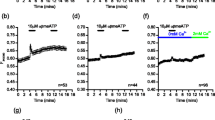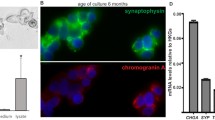Abstract
The molecular mechanism of action of several non-immunological histamine releasers has been investigated using pertussis toxin which interfers, via ADP-ribosylation, with some G-proteins. Pertussis toxin (100 ng/ml) inhibited histamine release induced by compound 48/80, substance P, mastoparan, peptide 401, bradykinin and spermine showing that a G-protein sensitive to pertussis toxin was involved in the non-immunological histamine release. All these compounds directly activate purified G-proteins. The sensitivity to pertussis toxin of this direct stimulatory effect was demonstrated for compound 48/80, mastoparan and substance P. Altogether these results suggest that a direct activation of G-protein might be the molecular mechanism of action of histamine secretagogues acting through a pertussis toxin sensitive G-protein and in this way mimic agonist-ligand receptor interaction.
Similar content being viewed by others
References
U. Blank, C. Ra, L. Miller, K. White, M. Metzger and J. P. Kinet,Complete structure and expression in transfected cells of high affinity IgE receptor, Nature (Lond.)337, 187–189 (1989).
M. Mousli, C. Bronner, J.-L. Bueb, E. Tschirhart, J.-P. Gies and Y. Landry,Activation of rat peritoneal mast cells by substance P and mastoparan. J. Pharmacol. Exp. Ther.250, 329–335 (1989).
T. Nakamura and M. Ui,Simultaneous inhibitions of inositol phospholipid breakdown, arachidonic acid release, and histamine secretion in mast cells by islet-activating protein, pertussis toxin. J. Biol. Chem.260, 3584–3593 (1985).
J.-L. Bueb, M. Mousli, Y. Landry and C. Bronner,A pertussis toxin-sensitive G protein is required to induce histamine release from rat peritoneal mast cells by bradykinin. Agents and Actions30, 98–101 (1990).
T. Higashijima, S. Yzu, T. Nakajima and E. M. Ross,Mastoparan, a peptide toxin from wasp venom, mimics receptors by activating GTP-binding regulatory proteins (G proteins). J. Biol. Chem.263, 6491–6494 (1988).
T. Higashijima, J. Burnier and E. M. Ross,Regulation of G i and G o by mastoparan, related amphiphilic peptides and hydrophobic amines: mechanism and structural determinants of activity. J. Biol. Chem.265, 14176–14186 (1990).
M. Mousli, C. Bronner, Y. Landry, J. Bockaert and B. Rouot,Direct activation of GTP-binding regulatory proteins (G proteins) by substance P and compound 48/80. FEBS Lett.259, 260–262 (1990).
B. Rouot, J. Carrette, M. Lafontan, P. Lan Tran, J. A. Fehrentz, J. Bockaert and M. Toutant,The adipocyte G o α-immuno reactive polypeptide is different from the α subunit of the brain G o protein. Biochem. J.260, 307–310 (1989).
P. E. R. Tatham, N. J. Cusack and B. D. Gomperts,Characterization of the ATP 4− receptor that mediates permeabilisation of rat mast cells. Eur. J. Pharmacol.147, 13–21 (1988).
M. Mousli, J.-L. Bueb, C. Bronner, B. Rouot and Y. Landry,G protein activation: a receptor-independent mode of action for cationic amphiphilic neuropeptides and venom peptides. Trends. Pharmacol. Sci.11, 358–362 (1990).
Author information
Authors and Affiliations
Rights and permissions
About this article
Cite this article
Mousli, M., Bueb, J.L., Rouot, B. et al. G-proteins as targets for non-immunological histamine releasers. Agents and Actions 33, 81–83 (1991). https://doi.org/10.1007/BF01993132
Issue Date:
DOI: https://doi.org/10.1007/BF01993132




